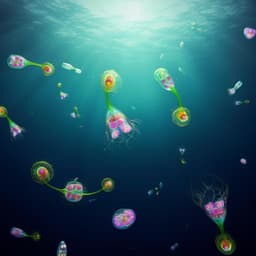
Environmental Studies and Forestry
Ocean alkalinity enhancement through restoration of blue carbon ecosystems
M. Fakhraee, N. J. Planavsky, et al.
This groundbreaking research by Mojtaba Fakhraee, Noah J. Planavsky, and Christopher T. Reinhard demonstrates how restoring blue carbon ecosystems like mangroves and seagrasses can permanently remove carbon dioxide from the atmosphere by increasing ocean alkalinity. Discover the significant implications of these findings for climate solutions and ecosystem restoration!
Playback language: English
Introduction
Global climate change necessitates sustained atmospheric CO2 removal alongside emission reductions to limit warming below 2°C. Natural CO2 removal methods, including afforestation/reforestation and coastal habitat restoration, offer economic and ecological co-benefits. Blue carbon ecosystems (BCEs), like mangroves and seagrasses, efficiently convert atmospheric CO2 into organic biomass, subsequently burying it in sediments. BCE restoration improves water quality, boosts biodiversity, benefits fisheries, and reduces storm damage. While BCEs cover a small percentage of the seafloor, their rapid carbon sequestration contributes significantly to global ocean sediment carbon burial. However, BCEs can also influence local carbonate chemistry, potentially acting as CO2 sources or sinks. High organic matter input increases aerobic and anaerobic respiration, impacting sedimentary CO2 pools, porewater pH, and alkalinity and DIC reservoirs. Increased alkalinity production in porewaters enhances marine CO2 uptake, achieving long-term ( >1000 years) carbon capture. This study systematically evaluates the potential for increased alkalinity export resulting from BCE restoration, a previously underappreciated aspect of their CO2 removal capacity. The research utilizes a stochastic modeling approach to investigate how restoring seagrass and mangrove ecosystems alters benthic marine redox dynamics to enhance ocean alkalinity.
Literature Review
Existing research highlights the significant role of blue carbon ecosystems in organic carbon burial and their various ecological benefits. Studies have shown that high organic matter input from BCEs can affect sedimentary carbon pools, porewater pH, and alkalinity. Previous work has explored alkalinity export from shallow marine ecosystems but hasn't systematically assessed the potential increase associated with BCE restoration. Some studies have suggested that under specific conditions, seagrass ecosystems could even be a source of CO2 due to calcification exceeding alkalinity production, particularly in systems with high allochthonous carbonate. The authors acknowledge this prior research and aim to address this gap in understanding by comprehensively evaluating the net impact of BCE restoration on alkalinity fluxes and CO2 removal.
Methodology
The study employed a time-dependent model of marine sediment biogeochemistry to simulate carbon, nitrogen, iron, and sulfur cycling under various environmental conditions. The model represents seagrass and mangrove environments, building upon established marine sediment biogeochemistry modeling practices. Alkalinity production from anaerobic respiration and calcium carbonate dissolution are emergent features of the model. The model also incorporates acidity production from the oxidation of reduced species and accounts for advection (by plants, animals, and tides) and methane cycling. The model was validated against measured depth profiles of key phases in modern seagrass and mangrove systems. The model successfully reproduced observed profiles of oxygen, DIC, alkalinity, and pH in different ecosystems with limited calibration, using observed ranges for boundary conditions. The organic matter flux from mangroves and seagrasses (rootzone fluxes) was the only parameter adjusted to match observed profiles, remaining within reported ranges for these regions. A stochastic approach was used, randomly varying environmental conditions and key model parameters within observational ranges to provide a statistical estimate of increased benthic alkalinity flux during BCE restoration under diverse scenarios. Varied parameters included reaction rate constants, organic and inorganic burial fluxes, bottom-water DIC and alkalinity, and advection extent. The model also considered the presence or absence of allochthonous, pre-formed carbonate to assess its impact on alkalinity. Potential CO2 removal was estimated by comparing total benthic alkalinity flux before and after restoration, using a CO2 uptake efficiency between 75% and 85%. The impact of ocean buffering was estimated using an uptake efficiency function, acknowledging that thermodynamic equilibrium and complete air-sea gas exchange are assumptions.
Key Findings
Modeling results consistently showed that restoring mangroves and seagrasses significantly enhances sediment alkalinity production, leading to surface water alkalinity enhancement and atmospheric CO2 uptake. Restoration causes a shoaling of oxygen penetration and increased alkalinity production via anaerobic respiration. Increased organic matter delivery to sediments from restored mangroves and seagrasses, compared to degraded ecosystems, results in elevated alkalinity production and increased alkalinity flux into the water column. High pre-formed calcium carbonate concentrations further enhance carbonate dissolution, driven by more intense acidity production linked to sulfide oxidation. Although a zone of increased acid production can drive carbonate dissolution, the net effect is transport of more alkaline waters, promoting CO2 uptake. The model explicitly accounts for potential CO2 evasion due to sulfate reduction lowering sediment pH. However, the analysis indicates that, for almost all cases, alkalinity production outpaces local calcification, making seagrass and mangrove ecosystems net CO2 sinks. Restored seagrass meadows can drive atmospheric CO2 uptake between 0.1 and 0.9 tCO2 ha⁻¹ per year, with higher rates in systems with high background calcium carbonate. Considering potential seagrass restoration areas, this could translate to -0.8 to 23 MtCO2 per year. Mangrove restoration shows considerably higher CO2 removal potential (-1-17 tCO2 ha⁻¹ per year) due to higher organic matter release, potentially removing -9 to 221 MtCO2 per year. Benthic methane (CH4) fluxes have a relatively minor offsetting effect on CO2 removal. Although increased organic matter and reduced oxygen penetration enhance CH4 production, its CO2-equivalent flux is generally small compared to the net increase in benthic alkalinity flux. The alkalinity-driven CO2 capture is a durable ( >1000 years) removal mechanism, unlike organic carbon burial, which is more susceptible to remobilization. The study highlights the importance of considering alkalinity fluxes in evaluating the CO2 removal potential of BCE restoration.
Discussion
The findings address the research question by demonstrating the significant role of alkalinity enhancement in CO2 removal during BCE restoration. The results are significant because they highlight a previously underappreciated mechanism of CO2 removal and underscore the value of BCE restoration. This mechanism offers a more durable form of CO2 sequestration compared to organic carbon burial. The study's relevance to the field lies in its comprehensive evaluation of the combined effects of organic and inorganic carbon cycling on CO2 removal in BCEs. The findings support the incorporation of inorganic carbon removal into the economic and regulatory frameworks governing BCE restoration projects. While the study acknowledges potential limitations due to assumptions like thermodynamic equilibrium and full gas exchange, the results provide valuable insights into the potential of BCE restoration for long-term carbon sequestration. Future work should explore the impacts of environmental stressors and refine estimates of CO2 removal rates for better market integration. Further investigation into the CO2 removal potential of salt marsh restoration is also warranted.
Conclusion
This research demonstrates that restoring blue carbon ecosystems, particularly mangroves, significantly enhances ocean alkalinity and facilitates long-term atmospheric CO2 removal. This alkalinity-driven CO2 capture mechanism is more durable than organic carbon burial. The findings highlight the importance of considering this process in evaluating the full climate change mitigation potential of BCE restoration efforts. Future research should investigate the impacts of environmental stressors and refine cost-benefit analyses to facilitate better integration of this important carbon sequestration mechanism into carbon markets. Further research on salt marshes' CO2 removal potential is also necessary.
Limitations
The study relies on modeling, which involves assumptions such as thermodynamic equilibrium and complete air-sea gas exchange in calculating CO2 uptake efficiency. The model's accuracy depends on the accuracy of input parameters and the representation of complex biogeochemical processes. The study doesn't explicitly model nitrous oxide fluxes, which could potentially impact the overall greenhouse gas budget. Finally, the high cost and maintenance needed for seagrass and mangrove restoration projects may limit their scalability and practical implementation.
Related Publications
Explore these studies to deepen your understanding of the subject.







